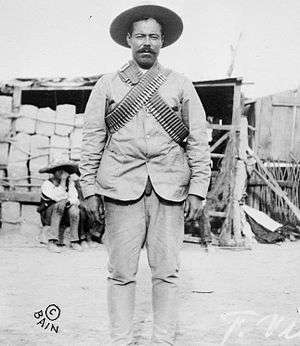Bandolier
A bandolier or a bandoleer is a pocketed belt for holding ammunition. It is usually slung sash-style over the shoulder, with the ammunition pockets across the midriff and chest.[1]

History
In its original form, it was common issue to soldiers from the 16th century to the 18th century, and contained either pre-packed chargers, small containers of wood, metal or cloth containing the measured amount of gunpowder for a single shot with muzzleloading muskets or other guns; or early forms of cartridges also containing a ball.[2] It might also carry grenades or other accessories for shooting. Any bag worn in the same style may also be described as a bandolier bag; similarly, pocketed belts holding ammunition worn around the waist may also be called bandoliers.
A somewhat different form of the bandolier came into use in the 19th century, when it held more modern metallic cartridges and hand grenades. Bandoliers are now less common due to the use of detachable magazines and belt-fed firearms, though extra ammunition belts are often carried around the body like a bandolier. They are, however, still often used with shotguns, hand grenades, and grenade launchers.
Shotgun shells can easily be stored in traditionally-designed bandoliers. In fact, some aftermarket shotgun slings are designed in a fashion similar to traditional bandoliers, albeit with a far more limited capacity.

Another modern use of a bandolier is for the automatic rifleman of a military fireteam. Since a squad automatic weapon is often belt-fed, an automatic rifleman will carry an extra belt on his person; either in a separate compartment or slung over the chest in bandolier fashion.
The bandolier was used to keep ammunition off a soldier's hips, as carrying too much weight on the hips can constrain movement and cause difficulty in retrieving the ammunition.
In World War I and World War II, bandoliers were issued primarily to riflemen. They were made of cloth, stitched into pockets which held clips of rifle ammunition. In civilian use, bandoliers are often worn by hunters and recreational shooters using shotguns.
Bandoliers made from spent or dummy rounds are sometimes used in fashion. Michael Jackson famously wore a bandolier as part of a military-inspired costume during his Dangerous World Tour in the early 1990s.
Popular culture
Fictional characters who have worn bandoliers include:
- Chewbacca from the Star Wars franchise (a bandolier is all he wears)
- Bebop and Rocksteady from the Teenage Mutant Ninja Turtles franchise
- Dinobot from the animated TV series Beast Wars: Transformers, in the episodes "Coming of the Fuzors" Part 1 and Part 2 (1997)
- Sir Roxton on the 1999-2002 TV series The Lost World
- Gargomon from the Digimon franchise
- The War Doctor, played by John Hurt in several 2013 episodes of the TV series Doctor Who
See also
References
- "bandolier". Merriam-Webster. Retrieved 15 July 2015.
- Chisholm, Hugh, ed. (1911). . Encyclopædia Britannica. 3 (11th ed.). Cambridge University Press. p. 313.